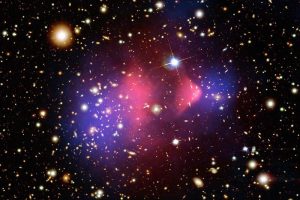Research Activities
Cosmology

A collision of clusters of galaxies, showing separation of dark matter (shaded blue) from normal matter (shaded pink).
Observations of galaxies, galaxy clusters, distant supernovae, and the cosmic microwave background radiation tell us that ~85% of the matter in the universe is comprised of dark matter. This form of matter may be made of elementary particles that interact only weakly with the normal matter described by the Standard Model of particle physics. Deciphering the nature of this dark matter would be of fundamental importance to cosmology, astrophysics, and particle physics.
The Cryogenic Dark Matter Search (SuperCDMS) is one of several collaborations performing experiments to directly detect these particles and thus understand the nature of the dark matter.
Direct Detection of Dark Matter Particles

Schematic of the interaction of a dark matter particle with a nucleus, showing the resulting energy deposition generating ionization and phonon signals.
According to models of cosmological structure formation, the luminous matter of galaxies is gravitationally bound to a more massive halo of dark matter. Should the dark matter of the universe consist of unidentified particles, our solar system and our planet would be passing through a flux of these dark matter particles which constitute the dark halo of the Milky Way galaxy. These dark matter particles could be detected directly using sensitive detectors located in underground laboratories, to shield them from interactions from normal matter particles. Such dark matter interactions would deposit a small, but measurable, amount of energy in an appropriately sensitive detector by elastically scattering from nuclei.
The SuperCDMS collaboration is searching for dark matter particles with masses smaller than ten times the mass of the proton. Such dark matter particles are a natural consequence of recent theories postulating the existence of a ‘dark sector’, paralleling the normal matter particles and interacting with them only weakly. Detecting these particles would open up a window into a completely unknown set of new particles.